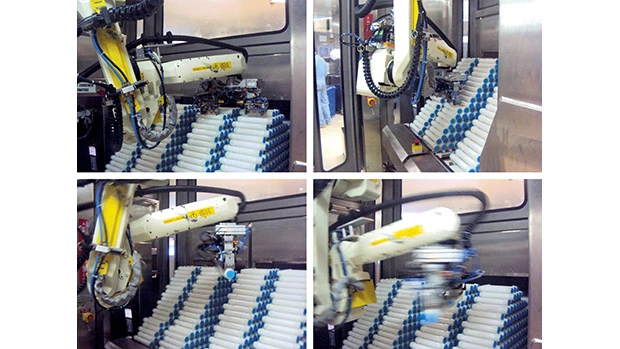
By Niels Erik Hansen, Ph.D.
 As automation technologies enhance a growing number of healthcare services – including imaging, surgery, radiotherapy and rehabilitation, among others – the pharmacy remains largely un-automated. Despite its important role in patient care, technicians in most pharmacies still compound medications manually, in much the same way it’s been done for generations.
As automation technologies enhance a growing number of healthcare services – including imaging, surgery, radiotherapy and rehabilitation, among others – the pharmacy remains largely un-automated. Despite its important role in patient care, technicians in most pharmacies still compound medications manually, in much the same way it’s been done for generations.
Such a long history, combined with refinements in aseptic techniques and training, means manual IV compounding remains the accepted standard of care. But how much longer should it be? Recent outbreaks of illness and adverse reactions linked to compounded medications, as well as numerous pharmacy product recalls, make the shortcomings of manual compounding increasingly hard to ignore.
Although pharmacy technicians are trained in the physical process of compounding, few understand the physics behind the process. And, being human, even the most experienced technicians make mistakes; some studies have documented observed manual error rates of up to 10 percent. Being able to repeat a compounding technique is not the same as ensuring accurate repeatability.
Ongoing reliance on manual techniques would be understandable if there were no alternative. But automated IV compounding systems have existed for more than a decade. Moreover, the technology – which is suitable for both hospitals and commercial compounding pharmacies – is proven to enhance the safety of compounded medications, reduce medication costs, and increase productivity. So why aren’t more pharmacies using it?
While pharmacists have generally welcomed technological innovation, many within the industry feel automated IV compounding technology is not yet sufficiently developed for widespread implementation. It’s an unfortunate perception, and inaccurate.
.JPG)
Automation is the use of machines, control systems and technology to increase productivity and the quality of goods beyond what is possible through human labor. The development of such technologies goes back more than three-quarters of a century – the first industrial robot was built in 1937 – and has undergone continuous enhancement and refinement ever since.
Today robotic automation is used to manufacture numerous products including cars, appliances, food, computers, and mobile devices, among others. Robots are particularly useful where a high degree of accuracy is required. For example, silicon chip manufacturing often requires tolerances measured in microns, orders of magnitude smaller than the tenth-of-a-millimeter measurements necessary in pharmacy compounding.
But in order to successfully automate any manufacturing process, it is essential to fully understand the process – inputs, weights and measures, individual production steps, and desired outputs. In other words, to automate medication compounding, you have to know how medication is compounded. Fortunately, the process and physics of medication compounding are well documented.
In more than a decade of research, a team of engineers worked to measure and quantify virtually every aspect of IV compounding. Their analysis included such variables as admixture fluid weight, surface tension, specific gravity and viscosity, differences in the diameter of ‘standard’ needle bore holes, the amount of force necessary for needles to puncture a vial stopper, and much more. The resulting IV automation technology, called RIVA, can account for the various physical properties of inputs and also compensate for variation.
For those who might look to output quality as evidence of production efficacy, pharmacy automation has proven a resounding success. Since RIVA technology was commercialized in 2008, systems have been installed at more than 30 sites worldwide and have cumulatively produced nearly 2 million IV doses safely and accurately. Further, installed units have performed more than 100,000 routine safety tests with zero failures. These numbers far exceed typical quality control validation measures for almost every type of manufacturing.
The bottom line is that pharmacy IV automation is a mature, well-established technology, with a solid record of quality control and output that is proven to be superior to manual processes. As numerous healthcare procedures are improved with automation, it is past time for automated compounding to become the standard of care in pharmacies. The benefits – reduced cost, increased efficiency and, most important, greatly enhanced medication and patient safety – make automated pharmacy compounding imperative.
 Dr. Niels Erik Hansen is president and CEO of Intelligent Hospital Systems in Winnipeg, Manitoba, Canada. He holds a Ph.D. in control engineering and an M.S. in mechanical engineering from Technical University of Denmark, and has more than 30 years’ experience in technology engineering and production with emphasis in motion control, fluid management, and environmental engineering.
Dr. Niels Erik Hansen is president and CEO of Intelligent Hospital Systems in Winnipeg, Manitoba, Canada. He holds a Ph.D. in control engineering and an M.S. in mechanical engineering from Technical University of Denmark, and has more than 30 years’ experience in technology engineering and production with emphasis in motion control, fluid management, and environmental engineering.
Latest from Today's Medical Developments
- Arcline to sell Medical Manufacturing Technologies to Perimeter Solutions
- Decline in German machine tool orders bottoming out
- Analysis, trends, and forecasts for the future of additive manufacturing
- BlueForge Alliance Webinar Series Part III: Integrate Nationally, Catalyze Locally
- Robot orders accelerate in Q3
- Pro Shrink TubeChiller makes shrink-fit tool holding safer, easier
- Revolutionizing biocompatibility: The role of amnion in next-generation medical devices
- #56 Lunch + Learn Podcast with Techman Robot + AMET Inc.
.JPG)






